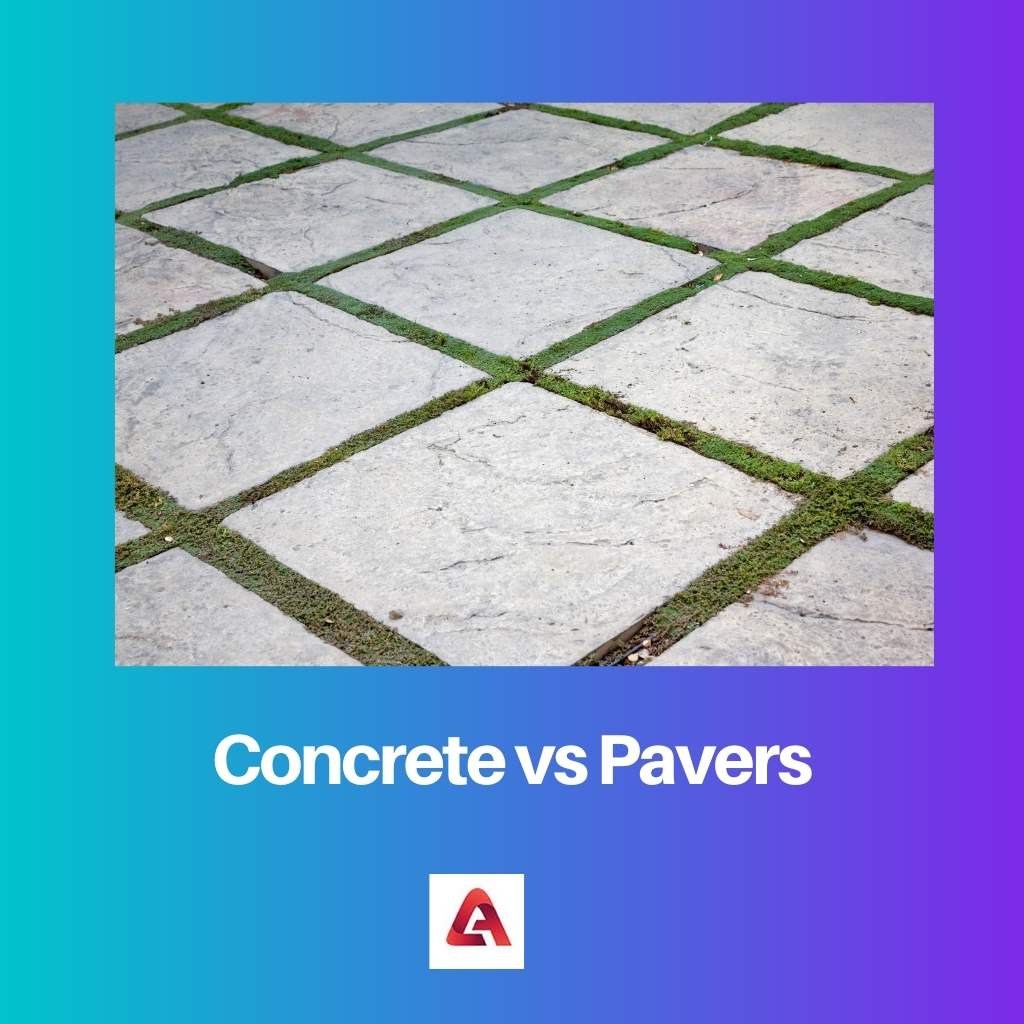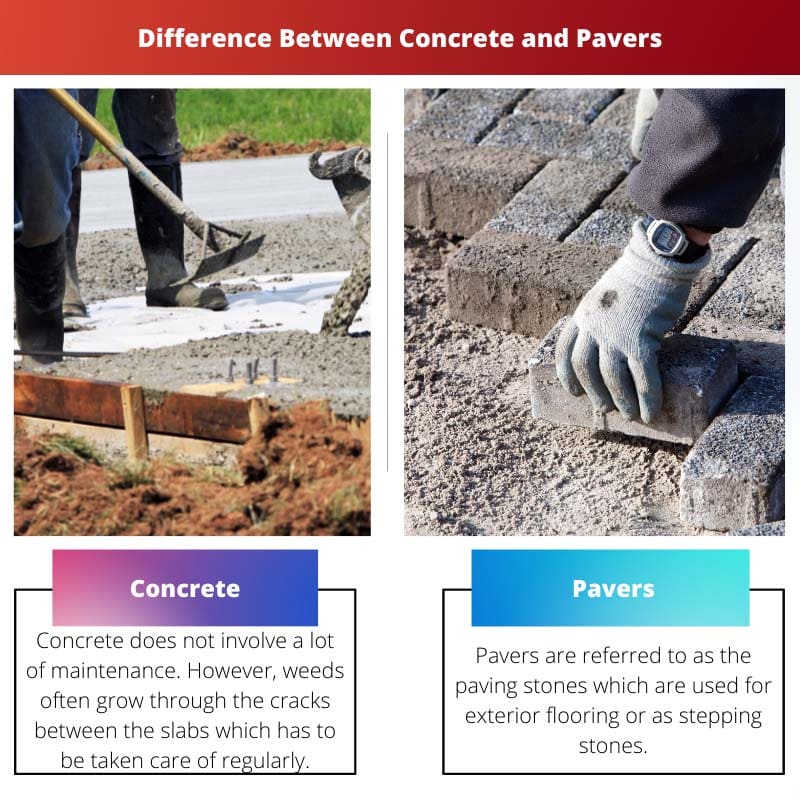Construction building materials are available in a wide range with various features. Each building material is unique. Several advantages and disadvantages are associated with each material.
The most popular and common building materials are concrete and pavers. They can be laid in the driveway, outdoor living area, walkway, and various other places.
Key Takeaways
- Concrete is a durable, low-maintenance material that can be poured in large, continuous slabs, while pavers are individual units made of various materials like brick or stone.
- Pavers offer more design flexibility and visual appeal, while concrete provides a uniform, seamless appearance.
- Concrete can be more susceptible to cracking, while pavers allow for easier repair and replacement of damaged sections.
Concrete vs Pavers
Concrete is poured in a single layer and allowed to dry, while pavers are laid individually in a pattern over a bed of sand or gravel and a solid, homogeneous material that can withstand heavy loads and weathering over time. Pavers are made of natural materials like stone, clay, or concrete.

Concrete is available only in two variants that are either stained or colored. Concrete is carved, engraved, or can be marked. Concrete is not moisture resistant and can crack in temperature fluctuations.
The installation process of concrete is not very complex. Concrete cannot be customized into various shapes or designs. It is comparatively less attractive than pavers.
While pavers are available in diverse colors, shapes, sizes, textures, and designs, pavers are sealed. Pavers are moisture-resistant and can easily resist high-traffic areas and temperature fluctuations without cracking or splitting.
The pavers installation process is more labour-oriented, complex, and long.
Comparison Table
| Parameters of Comparison | Concrete | Pavers |
|---|---|---|
| Strength | Tough and resistant to various changes and impacts | Comparatively stronger than concrete and can withstand more weight and impacts |
| Appearance | Less attractive and cannot be customized | More attractive and can be customized into different sizes, styles, colors, or patterns |
| Value addition | Does not increase the value of the property increases | The value of the property significantly |
| Maintenance | Low maintenance | High maintenance |
| Application | Best for outdoor residential areas or commercial spaces, fire pits, walkways, and other areas | Best for driveways, patios, planters walkways, pathways, and other areas |
What is Concrete?
Concrete does not involve a lot of maintenance. However, weeds grow through the cracks between the slabs, which must be taken care of regularly. Over time, concrete develops various stains that power washing can remove.
It can have a protective sealant to minimize staining issues.
Excessive traffic, ground movement, and temperature change can affect concrete. This can lead to splitting or cracking in the slabs. The building material does not offer high durability.
Concrete can further be divided into two types: plain concrete and stamped concrete with designs stamped on the surface.
The installation process of concrete is not very complex. It includes excavation, grading, preparation of the foundation, setting the forms, and pouring the concrete. The concrete takes several days to dry and cure before the customers can use it.
Sealants can also be applied over concrete.
Concrete is not visually appealing since there is no way of customization of the building material. The building material is best for customers on a tight budget who want strong materials.
In case of repair, replacement, or change, the concrete pathway would require an entire demolition and preparation of the mixture all over again.
What is Paver?
Pavers are referred to as paving stones, which are used for exterior flooring or as stepping stones. Pavers are made from a mixture of concrete, coloring agent and are put into a mould and are allowed to set into the shape.
Pavers are available for clay, brick, stone, or concrete materials.
Pavers are moulded pieces. They fit together closely or are interlocked at the area of installation. It is difficult to remove or replace pavers. The blocks provide more flexibility and adaptability than most other building materials.
They are easier to use in places that require renovation and are not constructed from scratch. Pavers should not be installed without the help of a professional, as incorrect installment can lead to cracking or shattering.
The pavers installation process is more labour-oriented, complex, and long.
The installation requires the following steps – excavation, sub-base compaction, installation of geotextile fibre, preparation and compaction of the base, preparation of sand, laying the pavers, cutting off the borders, preparation of bond beam, stone compaction, and ultimately sealing the pavers with sealant.
Pavers are customizable. They are available in diverse shapes, colors, sizes, and textures. Various designs can be created with pavers during installation. The designs provide an artistic look to the area.
Cement or concrete paint is used to install pavers made from cement, stone, or concrete.

Main Differences Between Concrete and Pavers
- Concrete can crack or break easily with movement or temperature change, while pavers are less prone to breaking and cracking from temperature change or movement.
- Concrete can support 2500 PSI, while pavers can support up to 8000 PSI.
- Concrete is not customizable, while pavers are customizable.
- Concrete is the best choice for customers on a budget, while pavers are the best choice for customers who are ready to splurge some extra bucks.
- The installation process of concrete is less labour-intensive, while the installation process of pavers is more labour-intensive.

- https://www.concrete.org/publications/internationalconcreteabstractsportal/m/details/id/1174
- https://www.mdpi.com/336684

The article is very detailed in its comparison of concrete and pavers. I appreciate the thorough explanation of the installation processes for both materials. This gives a clear picture of what to expect when choosing between concrete and pavers.
This comparison is really helpful for someone like me who’s not familiar with construction materials. I like how the article concisely explains the pros and cons of both concrete and pavers.
The post offers great insights about concrete and pavers and the differences between them. It’s very informative and helpful for homeowners who are thinking about which material to use for their projects.
I love this article, it provides all the information I’m looking for when thinking about renovating my home. I’m considering concrete instead of pavers, and your comparison was really helpful.
Great explanation of the differences between concrete and pavers. Very well-written and helpful. I appreciate the detailed comparison, it’s very informative.
The article presents a skewed view of concrete pavers by stating that they are high-maintenance. In my opinion, pavers can be low-maintenance if installed properly. The argument about the labour-intensive installation process doesn’t take into account the long-term benefits of using pavers. The writer should have provided a more balanced viewpoint.
I found the article to be quite insightful and well-researched. The information provided was unbiased and thorough, making it easy for homeowners like me to understand the differences between concrete and pavers. A great read!
The post doesn’t mention the cost comparison between concrete and pavers. It’s important to consider the long-term costs associated with these building materials. I’d like to see a more comprehensive analysis that includes the financial aspect of using concrete or pavers.
I totally agree with you, Johnson. A cost analysis would have been beneficial. The article should have covered the initial and long-term costs of using concrete and pavers so that readers can make a well-informed decision based on financial considerations.